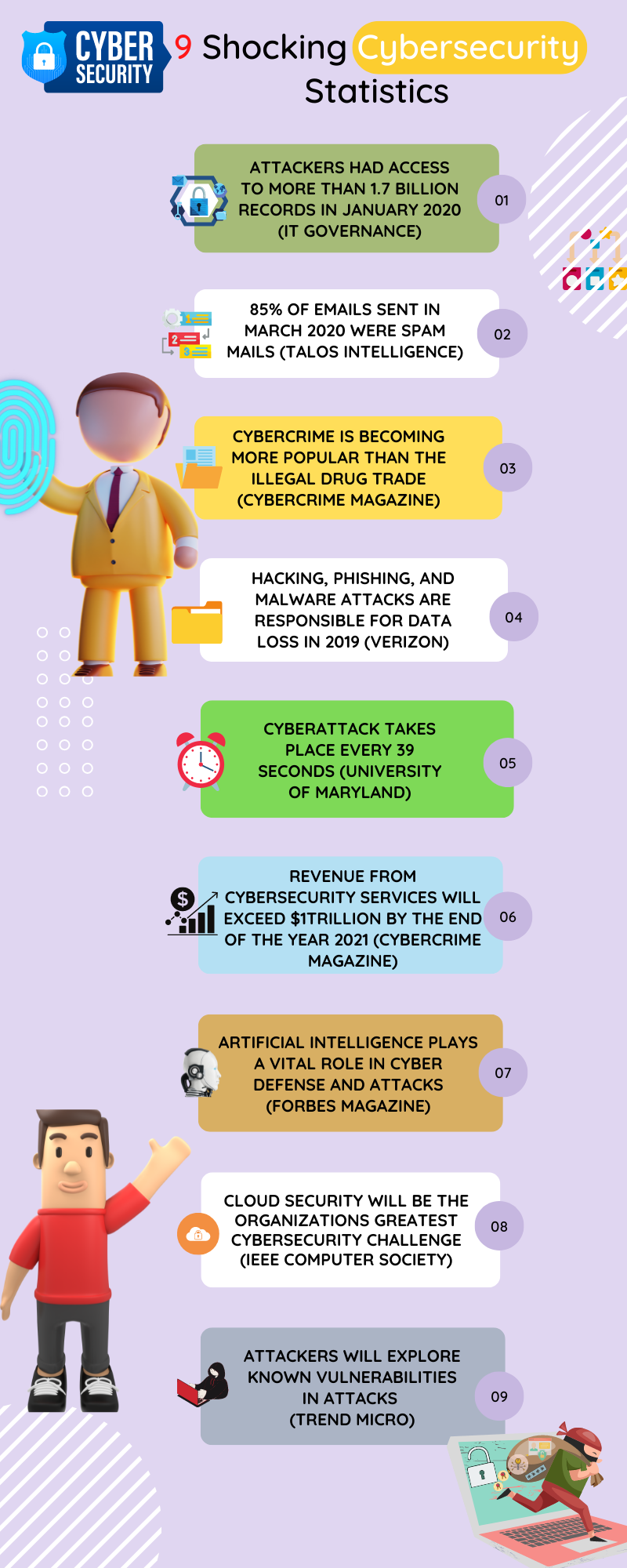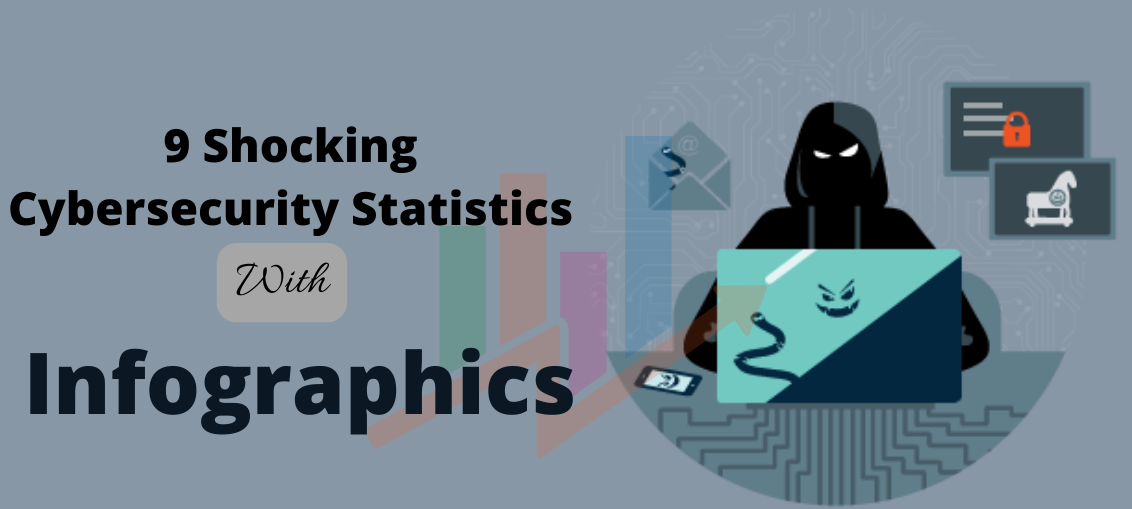This post will show you an infographic depicting 9 Shocking Cybersecurity Statistics.
Although cybersecurity is man’s greatest threat, it is fast becoming a tool shaping our lives and future. Hence, we can no longer ignore the resultant effect of cybersecurity in our lives.
A prominent example of the effect of cybersecurity relating to our daily lives brings to mind Edward Snowden’s revelations of how the privacy of human lives is being compromised on a large scale by the government.
Here are nine shocking cybersecurity statistics that will cause concern about cybersecurity issues.
Table of Contents
Shocking Cybersecurity Statistics
1. Attackers had access to more than 1.7 billion records in January 2020 (IT Governance)
Parts of the records accessed by the attackers in January include almost a billion usernames and passwords, over 850GB data leaks, etc.
CHECK OUT: Best Antivirus For 2023
2. 85% of emails sent in March 2020 were spam mails (Talos Intelligence)
It is a known fact that most phishing attempts come through spam mail. Hence, most spam emails will likely contain infected download links or links to counterfeit websites.
3. Cybercrime is becoming more popular than the illegal drug trade (Cybercrime Magazine)
Cybercrime is fast becoming more profitable than the illicit drug trade. Estimates show that over $6 trillion will be lost to cyber criminals by the end of the year 2021.
4. Hacking, phishing, and malware attacks are responsible for data loss in 2019 (Verizon)
Hacking is responsible for 52% of data loss; phishing is responsible for 32%, and 28% of data loss result from malware infection. 71% of the Phishing attacks were financially motivated.
5. Cyberattack takes place every 39 seconds (University of Maryland)
A study conducted by Michel Cukier, an assistant professor of mechanical engineering, shows that hackers are continually trying to hack into accounts using ‘brute force’ once every 39 seconds.
READ ALSO: 20 Best Cybersecurity Memes That Will Make You LOL
6. Revenue from cybersecurity services will exceed $1trillion by the end of the year 2021 (Cybercrime Magazine)
Cybersecurity ventures predict that spending on cybersecurity products and services will exceed $ 1 trillion by the end of 2021, up from $120 billion in 2017.
7. Artificial intelligence plays a vital role in cyber defence and attacks (Forbes Magazine)
While AI is useful for defence in cyberwars, it is also deployed by hackers and cybercriminals to hack and steal information. According to Forbes Magazine, ‘The race is between hackers, crackers, phishers, data thieves, and cybersecurity experts.’
8. Cloud security will be the organization’s greatest cybersecurity challenge (IEEE Computer Society)
Organizations make use of cloud services to store data and sensitive information. Therefore, cloud services will be a significant focus for malicious attacks, data breaches, DDoS attacks, and other cloud security threats.
This has led to massive investment in cloud security by major cloud companies like Microsoft, Google, and Amazon.
CHECK OUT: Best VPN For 2023
9. Attackers will explore known vulnerabilities in attacks (Trend Micro)
Most attacks will rely on available methods such as phishing, malware attacks, DDoS, etc. Hence, individuals and organizations should focus more on shielding themselves and businesses from public cybersecurity attacks.
Another cybersecurity example you might relate easily to is the rising attacks against individuals and organizations for financial gain.
Shocking Cybersecurity Statistics: FAQs
The digital landscape is constantly evolving, with it, the threats we face online. Cybersecurity statistics offer a glimpse into the scale and severity of cybercrime, highlighting the importance of taking proactive measures to protect ourselves and our data. Here are answers to frequently asked questions about these thought-provoking statistics:
Why are cybersecurity statistics vital?
Cybersecurity statistics provide valuable insights for various stakeholders, including:
- Individuals: Understanding the prevalence and impact of cyberattacks can empower individuals to adopt safer online practices.
- Organizations: Recognizing cybercrime’s financial and reputational risks helps businesses prioritize cybersecurity investments and implement effective defence strategies.
- Policymakers: Examining the evolving nature of cyber threats can inform the development of appropriate policies and regulations to protect citizens and critical infrastructure.
What are some frequently cited cybersecurity statistics?
Here are some examples:
- Frequency: According to Astra Security (2024), there are an average of 2,200 cyberattacks daily, occurring approximately every 39 seconds.
- Cost: The average data breach cost in the United States is $9.44 million (IBM, 2022), highlighting the significant financial implications of cybercrime.
- Human element: 74% of breaches involve a human element (Varonis, 2023), emphasizing the importance of employee cybersecurity awareness training.
- Vulnerabilities: In 2023 alone, over 28,778 new vulnerabilities were discovered (Astra Security, 2024), highlighting the continuous need for security updates and patching.
Should I be worried about these statistics?
While these statistics may seem alarming, it’s crucial to maintain a balanced perspective. Being informed about potential threats is empowering, and the statistics encourage proactive measures to mitigate risks:
- Implement strong cybersecurity practices: Regularly update software, use strong passwords, and be cautious about clicking on suspicious links or opening unknown attachments.
- Stay informed: Keep yourself updated on the latest cyber threats and trends. Resources like credible cybersecurity websites and podcasts can help.
- Invest in security solutions: Consider using security software like firewalls and antivirus programs to add an extra layer of protection.
Where can I find reliable cybersecurity statistics?
Several reputable organizations and research institutions publish cybersecurity statistics, including:
- Gartner (https://www.gartner.com/en)
- National Institute of Standards and Technology (NIST) (https://www.nist.gov/)
By understanding the scope and consequences of cyber threats and taking informed steps to protect yourself, you can navigate the digital world with greater confidence and security.

SUGGESTED READS
- Why Is Data Backup And Recovery So Important?
- How To Secure Devices Against Phishing Emails
- Cybercriminals Hijack Black Lives Matter to Spread Zombie Malware
- 3 Things You Need To Know About Cloud Backup In 2020
- Cybersecurity Trends To Know In 2020 (With Infographics)
- 7 Things You Need To Know About Cybersecurity And Payday Loans (Infographics)
- 9 Twitter Stats: Use These for Boosting Your Business
- How To Prepare Your Business For Data Loss
- The Surprising VPN Usage Statistics You Need to Know
About the Author:
Abraham Faisal is a professional content writer. He has a strong passion for online privacy, cybersecurity and blockchain and is an advocate for online privacy. He has been writing about these topics since 2018 and is a regular contributor to a number of publications. He has a degree in Computer Science and has in-depth knowledge of the ever-evolving world of digital security. In his free time, he likes to travel and explore new cultures.






